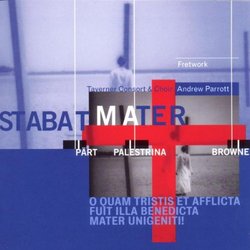Exceptional singing
12/07/1999
(5 out of 5 stars)
"This is a very interesting compilation, exploring the settings of Stabat Mater from Gregorian chant to the 20th-century composer Arvo Part. I bought this disc for Browne's Stabat Mater because I already had the Palestrina and the Part on other CD's, but I enjoyed the "journey through time" regardless of my original intent. As Matthew Westphal mentions, the Part piece is available on the Hilliard, in a comparable performance. The Palestrina piece comes from a glorious recording entitled The Music of the Sistine Chapel/Parrott (Virgin Veritas 61309 - buy, buy, buy! ). But there is NO other recording of Stabat Mater by Browne that would come even close to this performance. The artistry of the Taverner Choir and the sheer beauty of sound they produce are hard to match. Parrott directs Browne Stabat Mater by alternating choral and solo sections. Almost every singer in a 16-person choir gets his or her turn at a solo, but the most beautiful voices repeatedly take center stage (well, at least they're the most beautiful voices to me, namely Charles Daniels and Mark Padmore). In contrast, the uniformly choral rendition of this work by The Sixteen sounds bland. Browne Stabat Mater is part of the typical Tudor tradition, in which the singers were said to "jubilate" rather than simply sing. The work has characteristically florid lines, complex harmonies and effective sprinklings of peeling high voices. But what is unusual about this work is its emphasis on the words, especially highlighted by the solo sections. "The wall of sound," prevalent 50 years before the Eton Choirbook from which the Browne piece was taken, is being replaced by careful enunciation of individual words and phrases. Parrott's singers sing marvelously. I don't understand how Westphal can be so lukewarm about this wonderful recording."
Forget Hilliard Ensemble
Tjerk Schuringa | Amsterdam Netherlands | 10/24/2001
(5 out of 5 stars)
"Of course I got this album for Arvo Pärt's Stabat Mater. I was introduced to this work by the performance of the Hilliard Ensemble on Arbos. While a worthy interpretation, there was something not right, and it was the abundance of vibrato. By chance I came across the Fretwork performance, and the purity of it is overwhelming. The recording is clear, technically superb, the vocals stunning... There's no way I can listen to this CD dry-eyed"
Superb set of Stabat Maters
Etha Williams | 08/02/2008
(5 out of 5 stars)
"I came across this while looking for a recording of Palestrina's Stabat Mater. I listened to the MP3 sample of the Palestrina, and it was beyond anything I was expecting -- clear, perfect, and astoundingly touching; that short excerpt brought tears to my eyes. I later learned that the Palestrina was recorded using the One Voice Per Part (OVPP) practice, in which a single singer is assigned to each part. It works magnificently in this 8 voice work, with a clarity of polyphony I hadn't imagined was possible.
The other recordings on here are also excellent. Although I have not heard any other recordings of the Pärt, and thus have no basis for comparison, I found that it worked very well in the viol arrangement; the tone of these instruments complements the voices of the singers very nicely. Westphal (reviewing for Amazon) writes that "The viols can't replicate the violin family's intense singing tone and dynamic range; consequently, the expression of grief in the music is yet more abstracted." I didn't find this to be the case at all; while the viol may lack the qualities of the violin that many people idiomatically associate with "expressiveness," this recording is nonetheless suffused with emotion.
The Gregorian Chant and Browne recordings are also excellent, with similar technical clarity and musical sensitivity. If you have even the slightest interest in any of these works, I highly recommend purchasing this recording. It is a truly special experience."


 Track Listings (4) - Disc #1
Track Listings (4) - Disc #1